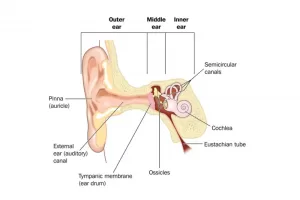Glue Ear- causes and treatment
What is Glue Ear?
- Glue Ear is when the middle ear fills up with with sticky fluid instead of air, over a period of weeks or months
- The middle ear is the air-filled central chamber of the ear, behind the eardrum.
- Over time, Glue Ear can lead to reduced hearing, speech problems and discomfort.
- While it usually gets better by itself, sometimes surgical treatment with ventilation tubes (grommets) is needed if a child’s hearing or speech is being affected.
How common is Glue Ear?
It’s thought to affect about 80% of kids before the age of 10, though it’s most common from 2 to 5 years of age. Most children grow out of it over time.
What are the symptoms of Glue Ear?
- Many children don’t show obvious symptoms of glue ear
- The first symptom may be reduced hearing- a child with glue ear make speak more loudly, may seem not to hear their parents or teacher, or may ask for the volume on the TV to be turned up!
- It may be picked up as speech difficulties in younger children
- Some children experience mild pain or discomfort in the ear, and unsettled sleep.
- Behavioural problems and irritability occasionally occur due poor hearing and/or discomfort.
- Less commonly, balance may be affected
What causes Glue Ear?
In many cases, the eustachian tube has become blocked- the eustachian tube is a tiny tube which passes from the middle ear into the back of the throat. Its job is to equalise air pressure across the eardrum, and to drain fluid out of the middle ear cavity. When it’s blocked (for example, due to a head cold or allergies), fluid builds up and Glue Ear can occur.
The following issues increase the chance of getting Glue Ear:
- Recurrent middle ear infections (otitis media)
- Hay Fever and allergic rhinitis
Children who live in a house where people smoke - Children who are in daycare or who have older siblings
- Down Syndrome
- Cleft Palate
Breastfed babies appear to have a lower chance of getting Glue Ear.
How is Glue Ear diagnosed?
- It is often suspected based on history- there may have been a recent head cold, an earache or a history of repeated ear infections, followed by symptoms of Glue Ear such as hearing or speech issues.
- It is usually confirmed when a doctor looks in a child’s ear and inspects the eardrum.
- A hearing test (audiology test) may also show issues with the hearing across the middle ear
What is the treatment for Glue Ear?
- In most cases, the fluid settles down over weeks or months.
- If it’s not causing significant problems with speech, hearing or pain, then no particular action is needed
- However, children with Cleft Palate or Down Syndrome are usually referred to a specialist without delay, as they may require closer follow up.
- Referral to an ENT specialist may also be recommended if a child has Glue Ear that is causing ongoing problems with hearing, speech, abnormal hearing tests or recurrent middle ear infections.
- Grommets (ventilation tubes) may be advised- this involves a hole being made in the eardrum, and a narrow plastic tube being inserted to allow ongoing drainage to occur. However, this procedure is less commonly done now than in the past, as it’s now known that Glue Ear tends to get better by itself, and it is not clear that grommets always make much different to speech & language development.

Grommet insertion- what does it involve?
- It’s usually a straight-forward operation, and generally doesn’t necessitate an overnight hospital stay
- The child will have a General Anaesthetic, which does pose some health risks- it’s important to ask your doctor about these
- A tiny surgical cut is made in the eardrum, fluid may be drained from the middle ear, and a ventilation tube (grommet) is inserted, which sits in the eardrum.
- Grommets tend to naturally fall out after 6-12 months, and the hole in the eardrum usually heals up quickly.
- Some kids may need to have grommets reinserted if Glue Ear comes back.
- While grommets are in place, it’s still OK for child to swim (they don’t need earplugs), though diving is discouraged. Air travel is also fine.
If you have further questions about Glue Ear, otitis media or grommets, speak to your GP.
Getting a Mental Health Care Plan in Australia: Your Guide
Getting a Mental Health Care Plan in Australia: Your Guide Mental health matters—and if you’re feeling overwhelmed, anxious, or down, a mental health care plan can help. But what is it, and how do [...]
UTI Symptoms and Treatment: What You Need to Know
UTI Symptoms and Treatment: What You Need to Know Urinary Tract Infections (UTIs) are common, uncomfortable, and often disruptive. But what exactly are the signs to watch for, and how can you get relief [...]
Free Mental Health Care Plan Online | Bulk-Billed by Qoctor
Free Mental Health Care Plan Online | Bulk-Billed by Qoctor Discover how to get a free, bulk-billed Mental Health Care Plan (MHCP) in Australia through Qoctor's telehealth service. Accessing [...]





